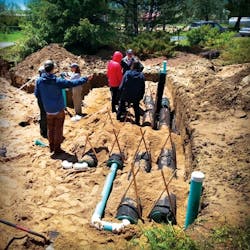About the author: Julie Cote is marketing for Presby Environmental. Cote can be reached at [email protected] or 603.837.3826.
A five-bedroom home’s septic system was failing and Colorado codes required a system that was larger than the lot could support in the location the homeowner, Virgil Russon, wanted the system installed. The initial cost and maintenance contracts for an aerobic treatment unit system were more than Russon could afford. He knew there must be a better option out there, even if it was not approved in his state. Colorado regulations are tightening up on operations and maintenance due to the high rate of failures when homeowners neglect taking care of these systems.
Selecting a Solution
Russon conducted research on alternatives to pipe and stone systems, and after coming across Advanced Enviro-Septic (AES), he believed the product could help his county and state by providing passive aerobic wastewater treatment without a large upfront cost or an ongoing operational maintenance cost.
AES is a commercial, residential and municipal advanced treatment system that was engineered to provide an environment for aerobic and anaerobic bacteria to thrive. Maximizing both treatment qualities of the different bacteria allows for superior digestion of organic material. The environment created inside the 12-in.-diameter pipe supports the bacteria passively by providing large surface area from various geotextile fabrics and plastic green fibers (40 sq ft per linear foot). The aerobic bacteria are fueled by the oxygen that passively enters the system by gravity flow from the differential venting system. The oxygen then migrates through the pipe holes into the surrounding System Sand (C-33 concrete sand), supplying oxygen from the outer circumference of the pipe to the bio-mat on the inside of the geotextile wrap. The tertiary treated effluent then is wicked through the System Sand into the surrounding soils. This effective and proprietary oxygen transfer allows for successful aerobic digestion of organic material when installed under parking facilities.
Russon contacted the manufacturer, Presby Environmental of Whitefield, N.H., and was put in contact with Jerry Lewinson of Environmental Quality Control LLC of Payson, Ariz., the Southwest distributor. With Lewinson’s help, Russon approached the engineering company Alles Taylor & Duke LLC of Evans, Colo. Bob Wright, lead engineer for the AES project, saw potential for the system in Colorado.
“The firm sees huge potential for the first time in resolving the problems of tiny lots that have failing systems and not enough reserve area to meet setback requirements or replacement system regulations,” said Mark Taylor, P.E., of Alles Taylor & Duke.
“My opinion is that this is not ‘experimental’ technology, but ‘new’ technology for Colorado, [as it has] worked in other states for 20 years,” Wright said. Currently, there are more than 250,000 AES systems installed worldwide.
Affording Approval
The process of gaining an approval from Colorado was nontraditional because AES did not fit into the current regulations. Though the product has been third-party tested, including for international certifications like NSF, BNQ and SAI Global, Colorado code does not allow for waivers. The state requires quarterly sampling and testing on at least 12 test systems installed in Colorado for about one year before it will grant a statewide approval on an alternative technology.
Sampling, monitoring and lab analysis is costly; however, Wright, the manufacturer and the state compromised and agreed to honor an ongoing system sampling protocol currently being done in Florida for two systems, which lessens the additional number of test systems needed to be installed in Colorado. It took about a year and a half working closely with the state and the Weld County Health Department for the regulations to receive an experimental approval. Alles Taylor & Duke absorbed much of the cost required to get the experimental approval, which included designing the test system and setting up the sample collection and test protocols.
“From a financial standpoint, the engineering work necessitated a substantial bill. For us, that was devastating, and we were considering backing out,” Russon said. “The engineering firm has been tremendous and although we will still have a substantial portion of that cost, they will be absorbing the bulk of it. I am very appreciative of them for doing this because it is the only thing that would enable us to install this system.”
From June 3 to 5, AES was installed on Russon’s property. Many county health regulators, Wright, Lewinson and the Russons were watching as the site was prepared for the system. The system can bend, be multilayered and have diverse bed shapes, making it particularly suited for small lots with setback requirements. This lot utilized AES’s ability to be in an unconventional shape due to the small size of the installation area and accommodation of the setback requirements. The AES system was designed with an arrowhead shape configuration under a previous driveway. The installation took three days.
“We are all partners in making this happen.” Russon said, after the work to get the passive solution to his county and later to the state. “We will be the test system for the county and state for the next year, with many people coming, sampling and observing the operation here in Colorado. Between the work of Bob, ourselves and Jerry, there are many key people who are now pushing for it in Colorado.”
Download: Here
